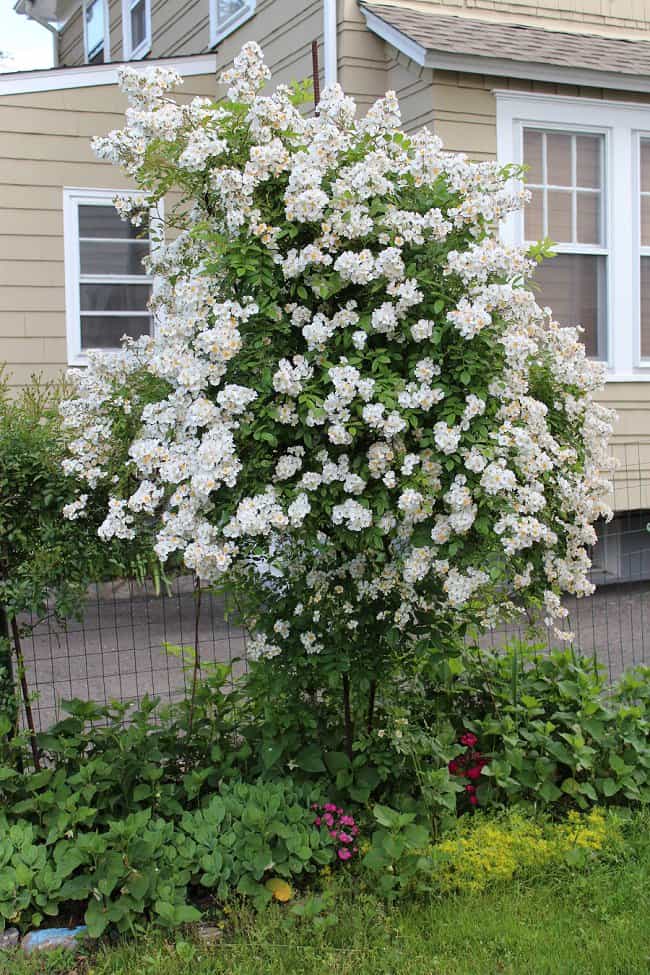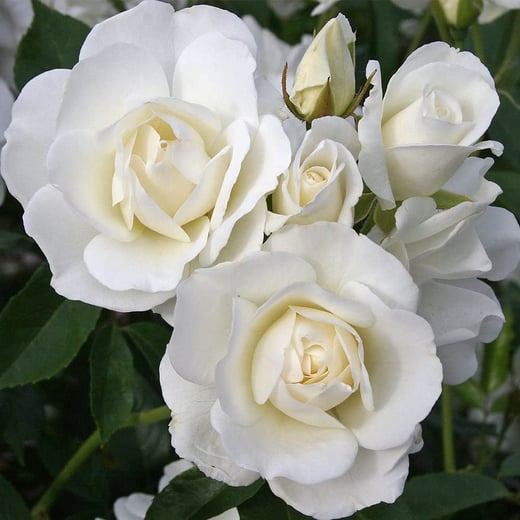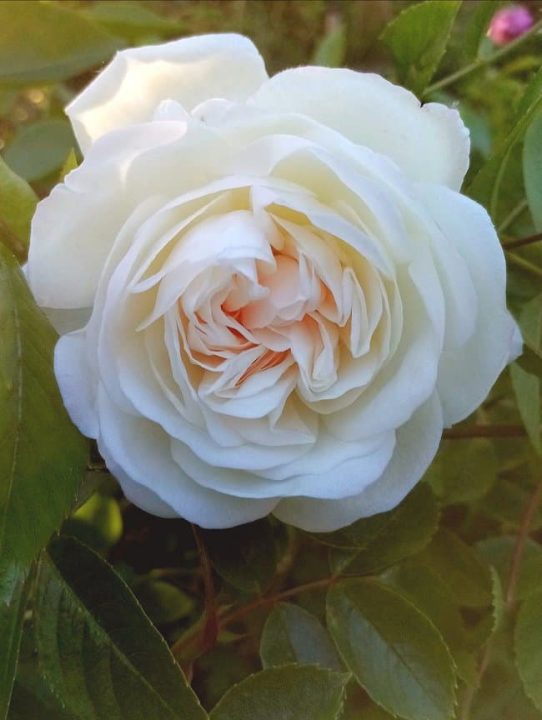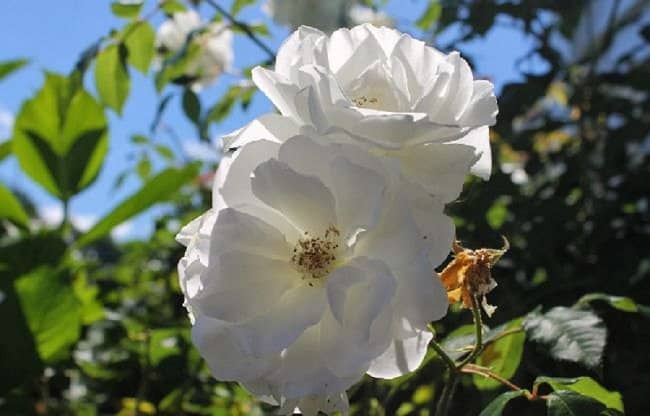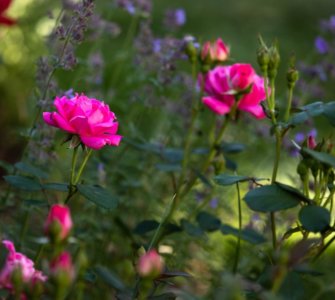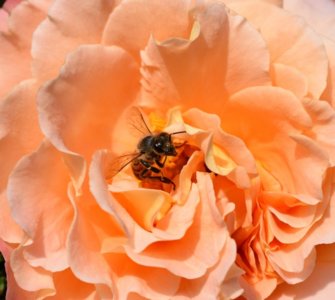There’s a little house at the end of our street, that has a secret garden. Every so often I catch a glimpse through the brickwork of winding pavements, olive trees and a flash of colour. Oh, and that amazing smell! While driving past one day I noticed the gardeners had left the gate open – and there in front of me was this incredible white rose bush.
Disclosure: We may earn commissions for purchases made through links in this post.
I got home and grabbed my rose identification book (yes, rose nerd alert) to find out that it was an Iceberg rose – so THAT was the cause of that beautiful scent! I’ve vowed to decorate my dream home with tons of these so I can have naturally perfumed and beautiful air all summer long.
One of the most popular varieties of rose, Iceberg roses come in many shapes and form. However, Iceberg roses are most recognisable for their original white, double-bloom, and their strong, sweet scent. They are a popular variety of climbing rose, but they also grow well as a standard or tall rose bush, reaching heights of 8-10ft tall. Iceberg roses are easy to grow, almost thornless, and semi-evergreen, meaning that in warmer climates they can flower almost all year round.
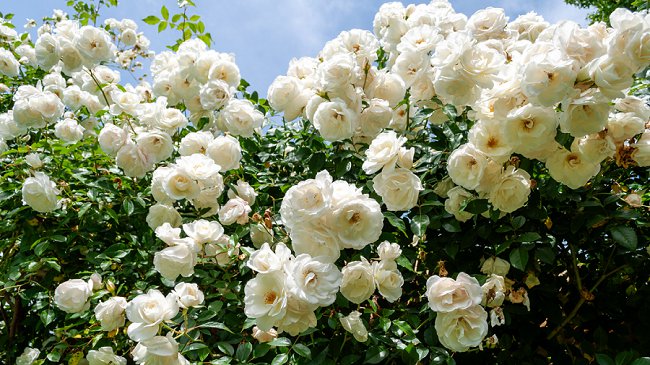
Although the Iceberg rose is easy to grow and a hardy, strong rose, like most roses, they do need a little extra care and protection. Sadly, like most species of David Austin rose, icebergs are not deer resistant – in fact, deer love them! So they will need a little protection if you are lucky enough to have a herd living nearby. They also need support structures in places to maintain their height and shape, and you will need to regularly check your Iceberg rose for signs of diseases that can harm any rose, even the hardy Iceberg.
Table of Contents
Why are iceberg roses so popular?
There are a few reasons why the Iceberg rose enjoys persistent popularity throughout the last half a century.
The Iceberg rose is one of the most fragrant rose species. Some describe the smell as honey or sweet in scent. This is not lost on the bees, either – the Iceberg rose is one of the varieties that are an absolute best choice for attracting bees!
The Iceberg rose is a creamy, milky white in colour. It repeat-blooms, meaning that clusters upon clusters of white flowers contrast the green foliage beautifully.
Growing the Iceberg is actually very beginner-friendly. They are a great starter rose, while still retaining that rewarding feeling that gardening gives. You can choose it in many different subvarieties – some are white, some are burgundy, some are climbers, some are bushes – some can even be trained into an actual shape of a tree!
Finally, the Iceberg is omnipresent for a good reason – it is popular due to its genetics. Compared to other roses, the Iceberg is very capable of producing flowers from the old wood. On older Icebergs, stems may get sticker, woodier and greyer as years pass, but this does not stop any Iceberg variety from producing green shoots from the old bark. Truly, a rare sight to see!
How do you care for an Iceberg rose?
Caring for an Iceberg isn’t all that different than caring for just about any other rose. It is a starter rose for a reason, meaning that caring for it isn’t a huge hassle of impossible conditions. That being said, it does have some variety-specific desires.
Feeding
Iceberg roses eat quite a lot. This is no surprise, as they are floribundas which repeat bloom. Commonly, Icebergs are found to have long blooming seasons. Gardeners generally tend to plant them for their massive flowering potential. If you live in a warmer climate, chances are that your Iceberg will be blooming all throughout the winter, as well!
However, vigorous growing and wild flowering require adequate fertilising to match. Use a balanced, organic fertiliser on your Icebergs, taking care to feed at least twice each flowering season to promote the growth potential and foliage development.
Your first application of fertiliser should be in the spring for a much-needed boost in nutrients after the frosts pass. Your second application should be just after the Iceberg start to open up first flowerbuds!
Watering
Water Icebergs regularly throughout the season. Keep the soil evenly moist, but avoid saturation caused by overwatering. In the absence of rainy days, provide about 2-3 cm of water additionally to your weekly watering habits.
For best results, water with a water hose to allow for even irrigation of soil around the Iceberg. Like all roses, Icebergs dislike their leaves being watered – leave that to the rain! 🙂
Soil choice
As with any other rose, the Iceberg loves a soil that is just a tiny bit acidic. Most of all, make sure the soil is well-draining and has a sandy component to allow drainage and prevent any fungal infections.
Sunlight
Icebergs are one of those roses that need their full sunlight. They need a minimum of 6-7 hours of sunlight a day, and this is non-negotiable!
A reason for this lays in their abundant flowering, complex flowers that are large and clustered. As such, the Iceberg, much like other floribundas, requires enough sunlight to get the energy necessary in creating, sustaining and repeat-producing show-stopping blooms.
Winter protection
While Icebergs are notoriously hardy, protection in winter is a must for colder climates. The protection process is called mulching, and it is best done before the first frost arrives. Read more here about how to prepare your climbing rose for the winter!
Mix sandy loam with some well-rotted compost until combined thoroughly. Form the mixture into a mound (about 20-30 cm tall) around the base of your rose bush. After the winter passes, remove the mound as the last frosts pass.
How do you prune a climbing iceberg rose?
While pruning is absolutely necessary for any rose, a typical shrub Iceberg does not have any preferential treatment during pruning.
Icebergs love their pruning in autumn, just like any other rose variety. The distinction is that in warmer climates – you may even have to prune in winter! Generally, the hotter the zone you are in, the more the Iceberg grows and flowers, the more pruning it needs.
Earlier in the article, I mentioned that Icebergs have an outstanding quality of producing new shoots out of old canes. This is something quite unlike quite a few varieties out there. With that, you have to be careful with pruning, and especially so if you have a climber!
Usually, older shoots on an Iceberg should not be cut until you have definite proof that it is very sick, very damaged, very dry or very dead.
In your first year with your Iceberg climber, strive to prune lightly. Cut away only the growth that doesn’t seem to be vibing with the rest of the structure and absolutely refuses to be tied back.
In your second year and in coming years, prune canes that seem to be going laterally and closing in on itself too much. Icebergs need air circulation, otherwise they can be prone to being struck with diseases. Tie back loosely to your structure of choice as the canes grow.
Before winter, you can opt to cut back up to one third of your rose overall. Otherwise, for a climber, light pruning is recommended.
(Psst…if you forget to prune, an Iceberg will thrive regardless!)
Should you deadhead Iceberg roses?
Deadheading is the process of removing blooms that are well past their prime. This encourages better and healthier growth, while improving the overall aesthetics of your prized bush. Definitely choose to deadhead!
Not only that, but the Iceberg is a repeat-blooming rose. Virtually all repeat-blooming roses benefit greatly from deadheading. The rose plant is allowed to redirect its energy into creating more blooms, making the flowering season all the more prolific!
Remove any spent, drooping and discolouring flowers from your Iceberg. Make sure to cut off the entire flowerhead cleanly, just below the base where it meets the stem.
Deadheading can be done all throughout the flowering season – the effect will be pretty much immediate as the Iceberg rushes to create more beautiful flowers fast!
Why are my Iceberg roses dying?
Iceberg roses are not invincible and there is a couple of reasons why they may not be doing so hot, even if you’re doing everything right.
Luckily, people who dedicated their lives to roses could clue me in on a few things that are very specific to Icebergs – and you might not even know is troubling them!
You are not meeting the needs of the rose
Basic, but often overlooked reason. Is your Iceberg getting a very minimum of 6 hours direct sunlight? Is the soil you’re growing it in right for it? Does it have enough nutrients? Is it underwatered or overwatered? When have you pruned it last?
Some of the most basic needs can go a long way, and this is absolutely the first thing to check if you notice sagging leaves, legginess, loss of colour or similar symptoms.
Nutrient deficiency
More than any other nutrient, Icebergs seem to prefer magnesium and nitrogen. If you notice that your Iceberg has turned leggy, spindly, grows really small blooms or dull foliage – this is the most likely culprit.
Most likely, you skipped on a feeding session or two, or the soil isn’t quite right. Fertilise the Iceberg twice per flowering season and mulch it after pruning. If that doesn’t improve its appearance within a few weeks, replant into a better quality soil.
Low Quality Soil
If the foliage of your Iceberg looks stressed, burned or you notice general rot or beginnings of slow-working dieback diseases, you might have a very salty soil.
Iceberg do not thrive well in salty soils, and generally, this is caused by underwatering. Make sure to water the rose at least three times a week in springtime and daily during hotter summer months. If your rose is in a container, make sure to increase these amounts.
Aphids
Yep. As hardy as can be, no rose is really safe from aphids, and neither is the Iceberg. Lucky for you, we have quite an effective way of dealing with them around here!
Powdery mildew
A fungal disease, powdery mildew is the bane of many rose varieties. Caused by damp and cool weather conditions, small white and grey dots may begin spreading along leaves and stems of your rose. They can spread like wildfire over the entire rose bush, making it important to prevent and treat timely.
Powdery mildew is a great factor in why proper pruning and air circulation are very important for an Iceberg rose. Treat with a baking soda spray.
Black spot
Another fungal disease, this time manifesting as black clustered dots on foliage. Black spot is caused by hot and humid environments.
Prevent it by pruning and providing good air flow and treat with a baking soda spray.
Can Iceberg roses grow in shade?
While many gardening websites tell you that an Iceberg is good for the shade, our experts respectfully (and resoundingly) disagree.
While Iceberg can definitely live in the shadow, it cannot thrive in the shade. As an abundant repeat-flowerer, Iceberg roses absolutely need at least 6 hours of full sunlight. That number is on the low side – any less than that, and it may affect how abundantly it flowers.
There is quite a long list of great shade-tolerant roses, but you might want to avoid the Iceberg if your garden is mostly shaded. Give your iceberg rose a sunny spot on a southern facing wall instead, and it will thank you for it!
Why is my Iceberg climbing rose not flowering?
You pruned in spring
Avoid pruning your climber Iceberg in spring. It just so happens that they do not prefer spring pruning, as they readily bloom on last year’s shoots and canes. They even grow from old wood!
Too little light
See how this ties in with their dislike of shade? An Iceberg in the shade simply can’t proliferate. You might get away with this in the warmer climates, but in colder climates, you will likely not see a climber Iceberg putting out its best blooms if you don’t provide enough direct sunlight.
Therefore, avoid planting climbing Icebergs on the northern sides of your home, balcony or garden.
Improper fertilisation
Make sure that the fertiliser is suited to the needs of your rose. With organic fertilisers, this might take a bit of experimenting. However, any Iceberg will be happy as long as it is getting enough nitrogen, phosphorus, magnesium and potassium.
For good, but gentle organic fertilisers, try coffee grounds or rice water!
Do Iceberg roses have thorns?
Whether an Iceberg has thorns depends very much on the variety you have.
If you prefer spiky stems, choose shrub or bush Iceberg roses (white, pink or burgundy varieties all have thorns).
For a near-thornless Iceberg variety, choosing and grow a climbing Iceberg.
Can I grow Iceberg roses in pots?
Icebergs are very happy with being exclusively potted plants. In case you are trying to grow a tall climber Iceberg, it is great to start training it straight from the container!
As always, when planting a container rose, make sure to give it extra attention. Icebergs are famous for sturdy and deep roots, so make sure to choose an adequately deep container. Additionally, make sure the container has holes at the bottom to allow drainage!
Water container Icebergs more frequently and don’t forget they still need their sunlight.
Can I get Iceberg roses at Home Depot?
To be honest, Iceberg roses are so popular, there isn’t a location where you can’t get them! You can definitely find several different Iceberg varieties, including the Iceberg climber at Home Depot.
However, do be careful to inspect a rose before paying for it and bringing it home, as department stores aren’t all that known for keeping their plants in tip-top condition.
Iceberg roses can be purchased straight from the Home Depot website for anywhere from 20 to 40 dollars, depending on the sub-variety.
Why do Iceberg roses turn pink?
There are generally two reasons why your Iceberg blooms have taken on a pinkish rim, or started producing young pink blooms.
While it may be an unusual and strangely pretty sight to see, Iceberg roses manifest this as a response to their sensitivity to the soil acidity.
Measure the acidity of your soil, as there might be a reason why it has changed. If your soil is not acidic enough, consider feeding it with rose fertiliser.
However, there is one more reason why your Icebergs may go Barbie pink – it has to do with cool and damp nights.
This is especially common in colder climates in autumn and winter. Pink spots are usually caused by dew or rain which stays on the petals all throughout the night. In the morning, the sunlight singes the leaves, which in turn leads to the characteristic pinking, usually at the very outside of the edges of the bloom. While it might look nice, this is actually the reaction of the Iceberg to a fungal intrusion into the petals.
Adjust the environment around your Iceberg at night (if potted). Usually, pink hue tends to resolve and revert to white as days and nights become warmer.
Finally, some sub-varieties of Iceberg rose do have a pinkish tinge at certain points of the blooming process.
How much does an Iceberg rose cost?
Depending on where you are looking, expect to pay not more than 40 dollars for a single iceberg rose.
The wonderful folks at David Austin Flowers sell their blooms with a guarantee! You can get a potted shrub or climbing Iceberg rose for about 25 dollars, or a bare root rose variety for about 22 to 25 dollars.
If raising a rose from seed is your game, expect to pay about 10 dollars for a bag of Iceberg rose seeds.
What zones do Iceberg roses grow best in?
Iceberg roses will thrive in USDA zones 5A to 9A, due to how naturally hardy they are. Optimally, Iceberg roses are native to California, Texas, Nevada and Hawaii. They prefer weather that is very warm but with low humidity and infrequent rainfall. The more warmer your zone, the more often an Iceberg blooms!
That is it for Iceberg roses! I can’t wait to eventually buy my dream home and grow these climbing beauties everywhere!
